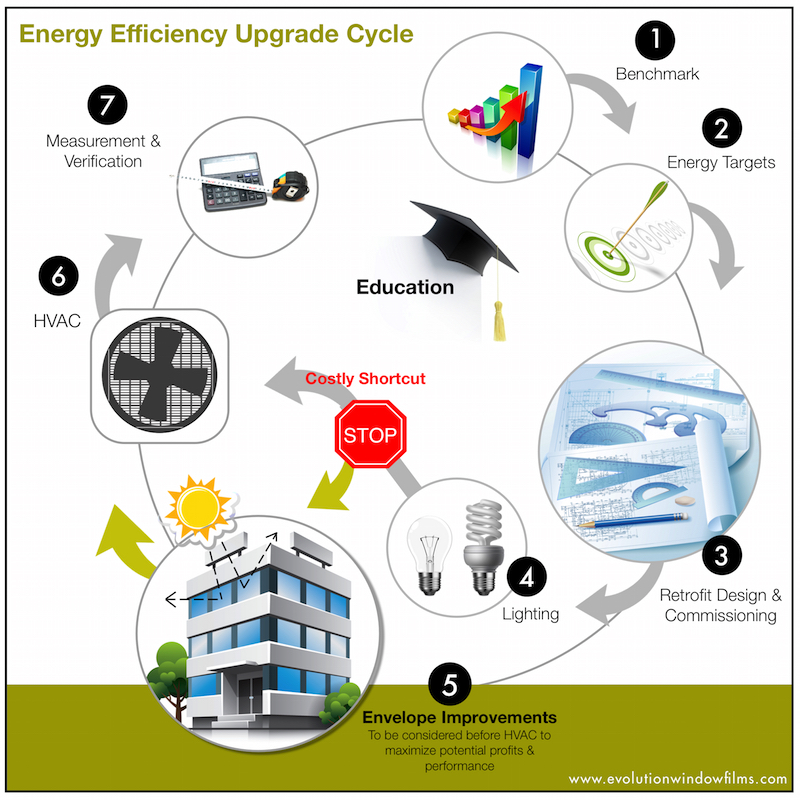Blog
Energy Efficiency Steps to Retrofit a building and optimize investment.
There are many opportunities to conserve energy for business and home owners. With new research and the advancement in technology new products and techniques are now available to help preserve the environment, improve health and wellness for occupants, and save money.
When considering upgrading you building with energy saving products, consider the sequence that they are implemented. HVAC equipment and lighting is often the priority for energy saving investments, while the outer envelope of the building (such as windows), is left as secondary. If you have large areas of windows, the benefits of installing solar control window film first will help maximize the profitability of your initial investment, but also long term energy savings.
Steps to optimize your Building’s Energy Efficiency
Upgrade Building Retrofit Cycle
Set Benchmarks
Work with industry professionals to help understand what is typical for your type of home or business located in your area.
Energy Targets
What do you want to achieve? How will you evaluate your success? What resources do you need to be able to reach these goals? Set your vision high, but be realistic with your expectations. It is a marathon, not a sprint.
Office Design
Are you planning a new office design or renovation? Consider installing window film at the beginning of your upgrade cycle. Your interior designer will be able to incorporate seating areas close to the windows without needing blinds or shades to be drawn all the time. Seating close to natural light offers health and wellness benefits for employees, but also increases natural lighting to help with task lighting during the daytime; which means less time needed for electrical task or overhead lighting. They will also have the confidence that sunny windows can be enjoyed offering u.v. protection to both workers and interior fabrics, as well as hot spots virtually eliminated.
Lighting
Even though lighting often comes before upgrading the envelope of the building, consider the benefits that window film can offer that may affect lighting. If you have windows where blinds or shades are constantly being pulled because of the glare on computer screens, or hot spots, you may be able to use less interior task lighting during daylight hours.
Envelope Improvements, including Window Film
Consider the envelope of the building; including windows, doors, walls, and other exterior parts of the building. These improvements are often times overlooked and should be considered before a new or upgraded mechanical system is installed. Although the mechanical system (and how it operates) has an important role in determining the energy efficiency of our buildings, the building envelope influences the overall energy consumption.
HVAC System
Install the window film first to lower the heat load caused by sun coming in through the windows. By doing this you may be able to downsize the size of HVAC equipment needed, and it will lessen the heat load burden of the installed system.
Even in colder climates excess heat gain can be a problem. Having window film applied can save on air-conditioning and heating costs:
If a building has mainly large glass areas facing north and south, additional cooling may be needed to maintain comfort for offices on the southern exposure,” says Steve Debusk, energy solutions manager, CP Films. “In situations like this, offices on the northern exposure are typically overcooled and uncomfortable. By reducing the solar heat gain on south facing offices, the air conditioning system is better able to maintain comfortable conditions for all.
South- and west-facing walls can be getting too much heat, even in winter, which can require air conditioning,” says John Miller, a spokesman for V-Kool. “That can be true even on days when heat is running in other parts of the building. [1]
Success – Measurement, Verification, and Education
Using the evaluation methods determined at the beginning of this energy saving project, make sure to measure and verify the improvement on the building’s energy consumption. Three main factors affect the energy performance of a building: HVAC System & Operations, Occupancy & Lifestyle, and Building Envelope [2]. In addition to the installation of quality energy saving products, educating and encouraging occupants on energy savings best practices and habits will help to improve the probability of success.

References
[1] Quoted in the article – Window Film: A Window of Opportunity
[2] Maleki, Afarin, Life-Cycle Cost Evaluation of Building Envelope Energy Retrofits (2009) p. 4 & 5 (referenced download paper – University of Toronto Library)




